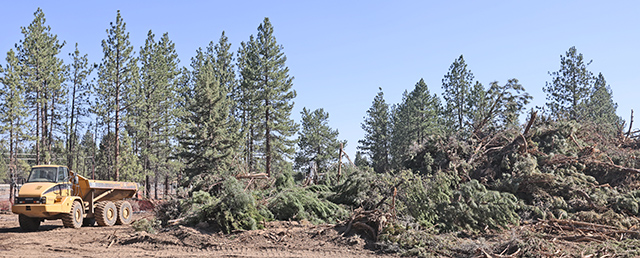SNAP cuts hit local families
Published 1:21 pm Friday, November 15, 2013

- SNAP cuts hit local families
The Freel family is on the SNAP diet.
SNAP, the Supplemental Nutritional Assistance Program, provides food money for low-income Americans. The roughly $600 the Bend family of five gets through the federally funded program each month covers all of their food.
Trending
Even though Brandy Freel works full time behind Wal-Mart’s meat counter and her husband works part-time, every dollar of their paychecks is spoken for after rent, utilities and phones. That makes SNAP crucial when it comes to feeding the couple and their three boys, ages 5, 7 and 13.
“I’m grateful for the program, because if I didn’t have it, my kids wouldn’t be able to eat,” said Freel, 34.
But their diet just got a little stricter.
Families like the Freels — who are among the more than 45,000 Central Oregonians who rely on SNAP — who saw smaller monthly benefits as of Nov. 1, which is when the 2009 stimulus funding that had propped up the program ran out. President Obama signed the American Reinvestment and Recovery Act amid economic crisis, sending streams of money to things like school districts and local governments.
Now, more than five years later, that extra money is drying up.
The amount families lose depends on their benefit levels, which are calculated using a combination of income, household size and expenses. A family of four that received the maximum benefit amount under the stimulus funding — $668 — will see $36 less each month. An individual who used to receive the maximum $200 will see $11 less per month.
Trending
And even bigger cuts could be coming. Congressional leaders are negotiating between dramatically different versions of the Farm Bill approved by the Senate and the House of Representatives. The Farm Bill historically has included funding for SNAP.
For Freel, who already had been keeping a close eye on her food budget, the more than $30 per month cut she’ll see is going to hurt.
“For a family of five, that’s a pretty significant cut,” she said.
Improved food security
At Grandma’s House in Bend, a shelter for pregnant and parenting teens, Director Woody Medeiros and her staff do a lot more than just help young girls get their SNAP benefits: They teach them how to get the most nutrition for their buck.
Together, the staff and clients design meal plans with the recommended amounts of protein. The clients learn which vegetables have the most calcium. How to replace meat, in some cases. The staff takes them grocery shopping and hosts cooking classes.
For pregnant teens, that’s crucial, Medeiros said.
“There’s things the baby needs, and they will take it from the mom regardless if she’s able to provide it or not,” she said. “Their attention span, their overall well-being is not good if they’re not eating well.”
SNAP benefits don’t come with strict guidelines on what people can buy. The current rule allows for “any food or food product for home consumption.” People can also buy seeds and plants to grow their own food.
Still, the program’s supporters, recipients and researchers say SNAP, known until 2008 as the Food Stamp Program, has done a lot of work toward reducing food insecurity in Oregon and across the country. Food security refers to a lack of money or other resources that limits consistent access to adequate food, according to the U.S. Department of Agriculture.
Food insecurity dropped by an average of 10 percent among U.S. households within about six months of joining SNAP, according to an August study by Mathematica Policy Research. In that same time, child food insecurity decreased by roughly one-third in SNAP households, the study found.
Belit Burke, Oregon’s SNAP manager, said Oregon tends to fall below the national average for overall food insecurity, and SNAP has helped improve access to healthy foods for many families.
Oregon’s social services providers are good at coordinating to make sure everyone who needs help gets it, she said. For example, leaders with SNAP and the Child Nutrition Programs, which provide breakfasts, lunches and milk to children nationwide, do weekly data analyses to ensure all children who are eligible for free and reduced lunch get it.
“We work really hard to try to make sure we’re feeding kids in Oregon,” Burke said.
Still, Feeding America’s 2012 report on child food insecurity said 29 percent of kids in Oregon, or more than 850,000, were considered food insecure, the second-highest rate in the nation behind Washington, D.C.
Freel said she uses her SNAP money to buy essentials including meat, cereal, milk, fruit and vegetables. Like most kids, hers would like to see more candy and junk food on the shelves, but she said she rarely buys things like that.
The family’s favorite meals are spaghetti, steak and potatoes and fried chicken.
“Pretty basic stuff like that,” she said.
‘It has to come from somewhere’
Advocates say every dollar that’s cut from SNAP threatens the food security of families who depend on the money.
Many people who rely on SNAP are on a fixed budget and live on “SNAP diets,” meaning their entire food allotment is contained within their SNAP benefits, Burke said. For people like that, even $15 can be a substantial loss, she said.
“If you take away even that extra gallon of milk from someone, they feel it,” Burke said. “It’s a really difficult thing to do. These are folks that generally are living under little money.”
For the girls at Grandma’s House, the monthly cut could remove, say, the meat from their diet, Medeiros said.
“It could be the protein piece,” she said. “It could be the milk. It has to come from somewhere.”
For seniors, getting SNAP benefits can be a matter of life or death, said Pamela Norr, executive officer of the Central Oregon Council on Aging, which helps seniors connect with SNAP.
“Any cuts to senior funding makes significant and drastic changes to seniors and puts them at further risk,” she said, “Any cuts to a food stamp program puts those that are most vulnerable and most at risk in further danger — and, for seniors, that can be life threatening.”
While Burke said she’s concerned about the stimulus-related cuts, potential cuts that could come as a result of proposed versions of the Farm Bill would be “pretty substantial.”
The House of Representatives passed a version of the Farm Bill that would result in dramatically reduced eligibility for Oregon’s SNAP. Anyone above 130 percent of the federal poverty level — about $30,600 for a family of four — would no longer be able to receive SNAP benefits. Currently, Oregon’s income limit is 185 percent of the federal poverty level, about $43,500 for a family of four.
Under that plan, more than 90,000 Oregon residents — more than 30,000 of those children — would immediately lose their SNAP benefits, a combined loss of about $3 million in benefits.
Oregon is different from other states in that it doesn’t have a lot of big industry to support the working poor, Burke said. Thirty percent of the state’s SNAP recipients are working; they’re just not making enough money to pay the bills, she said.
“Most of these people want to go to work, they want jobs and they are working; they’re just not working enough hours and they’re not making enough money to be able to go off of assistance,” Burke said.
Freel said she works hard every day, but sometimes it’s still not enough to pay all of the bills.
“A lot of people think that SNAP is for people that don’t work and families that are drug addicts and stuff,” she said. “It’s not. It’s there for people that actually need it to provide for their families.”
How to grow your brain
Researchers at the University of Pittsburgh found that walkers increased the size of their hippocampus, the region of the brain that controls new memories, by 2 percent after one year of walking 40 minutes three times a week.
The researchers divided 120 older adults, average age 66, who did not have dementia, into two groups: a stretching group and a walking group. The group that walked increased their hippocampus, while the stretching group showed no improvement, according to the 2010 study published in the Proceedings of the National Academy of Sciences.
Normally, that area of the brain decreases about 1 to 2 percent a year in adults, said Dr. Jay Van Gerpen, increasing their risk for developing Alzheimer’s.







